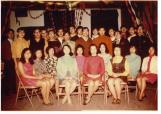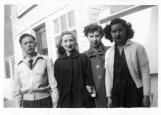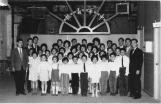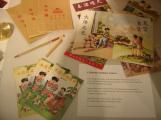1
University student party time at the Chinese Athletic Club
1969

2
Attending public school had quickly made English a first language for most second generation Chinese. Most Canadian-born Chinese were faced with the difficult position of trying to negotiate what it meant to be a Canadian when they lived in what amounted to a ‘Chinese' home, but functioned in a ‘Canadian' society.
3
David Mark with Moose Jaw waitresses
1950

4
Article regarding the opening of the Chinese school in Moose Jaw
1970

5
Many parents tried to guard against loss of language and cultural identity by establishing an after school Chinese school. "When it came down to the crunch, they did say we are Chinese. Even though we couldn't understand their etiquette. We couldn't understand why they did things." The hope was implicit that in learning to speak Chinese, the door would open for cultural understanding to follow and that these types of misunderstandings would be resolved.
6
Student and teachers at the afterschool Chinese classes in the mid to late 1960s
1960

7
A teacher from Regina or, when one was unavailable, parents from the community taught spoken and written Chinese to youngsters from the community. They used textbooks from China, which were brought over directly or purchased in Vancouver.
8
Chinese United Church, summer of 2005
1 August 2005
303 High Street West, Moose Jaw, Saskatchewan

9
Classes took place at either the Chinese United Church or the Chinese Benevolent Society premises for about two hours every or almost every day after school.
10
Educational materials used in the Chinese School
1970

11
But whether or not after school classes made an impact on children's abilities to speak, read and write Chinese, Chinese school performed multiple other functions: most notably getting the Chinese children from the community to socialize with each other.